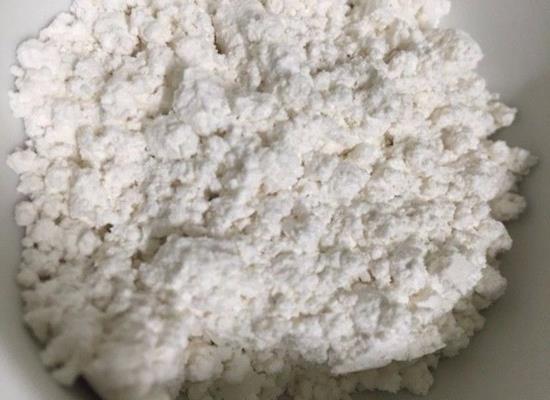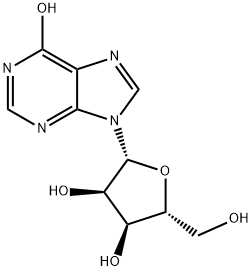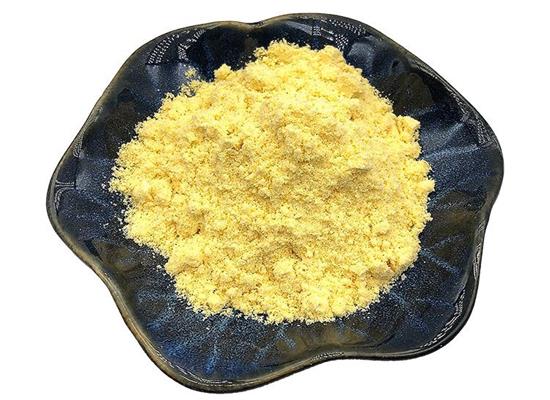Inosine: Physicochemical Properties and Role in Alzheimer's Disease
General Description
Inosine, a purine nucleoside, exhibits unique physicochemical properties that influence its role in various physiological processes, including its potential impact on Alzheimer's Disease (AD). Studies indicate that inosine levels vary in different AD models, with some showing increased levels while others, particularly in Alzheimer's patients, reveal decreased serum inosine. This dysregulation may contribute to neuroinflammation and cognitive impairments associated with AD. Given its antioxidant and neuroprotective properties, inosine presents a promising therapeutic target for mitigating cognitive decline, warranting further research into its potential as a treatment option in combating neurodegeneration in Alzheimer's Disease.

Figure 1. Inosine
Physicochemical Properties
Structural Characteristics
Inosine is a purine nucleoside characterized by its unique structure, comprising a ribofuranose sugar linked to a hypoxanthine base through a beta-N9 glycosidic bond. This structural formation distinguishes inosine from other nucleosides, particularly guanosine, which features an additional exocyclic amino group. The presence of such a bond affects the molecular stability and interaction of inosine in various biochemical environments. Spectroscopic studies have effectively characterized the ultraviolet spectra of inosine, revealing an absorption maximum at 250 nanometers at neutral pH, which provides essential insights into its interactions and stability in biological systems. Furthermore, studies utilizing techniques such as Raman spectroscopy have identified unique vibrational bands for inosine, aiding in understanding its molecular behavior and properties. 1
Conformational Dynamics and Tautomeric Stability
The conformational dynamics of inosine demonstrate its intrinsic flexibility and stability under varying conditions. X-ray crystallography and nuclear magnetic resonance studies have shown that inosine predominantly adopts an anti conformation in solid-state, while solution-phase behaviors indicate a complex distribution of conformers, notably a preference for the syn conformation under specific conditions. Various tautomeric forms of inosine have been investigated through quantum chemical methods, revealing that the N1H tautomer exhibits significant stability across different environments. Additionally, the predictions regarding the energetics of tautomers highlight the diverse reactivity and interaction potential of inosine in both polar and nonpolar conditions. Such insights underline the critical role that the physicochemical properties of inosine play in biochemical processes, particularly in the context of nucleic acid functionality and stability. 1
Role of Inosine in Alzheimer's Disease
Inosine is a nucleoside that plays a significant role in various physiological processes, and its potential impact on Alzheimer's Disease (AD) has garnered attention in recent research. AD is a complex neurodegenerative disorder characterized by the accumulation of beta-amyloid plaques and tau tangles, leading to cognitive decline. Recent studies suggest that inosine could influence inflammatory responses and oxidative stress in the context of AD. For instance, the lack of inosine in certain mouse models of AD has been linked to increased pro-inflammatory cytokines, proposing that inosine deficiency may exacerbate neuroinflammation and cognitive impairments. 2
Inosine Levels in Alzheimer's Pathology
Several studies have observed varying levels of inosine in different models and stages of AD. Research indicates that while certain transgenic mouse models exhibit elevated inosine levels, studies conducted on Alzheimer's patients have found reduced levels of inosine in their serum. This inconsistency points to a potential dysregulation of inosine in the pathological state of AD. Specifically, early-stage Alzheimer's patients showed decreased inosine levels in the frontal cortex, suggesting that such deficits could contribute to the cognitive impairments associated with the disease. In contrast, other regions, such as the parietal and temporal cortices, presented increased inosine levels at specific stages, indicating a complex relationship between inosine and neuronal health. 2
Therapeutic Potential in Alzheimer's Disease
Given its antioxidant and neuroprotective properties, inosine presents a promising therapeutic target for AD. There is a hypothesis that combining inosine with other antioxidants, such as ascorbic acid, could help mitigate the progression of cognitive decline in Alzheimer's patients. Although the current literature does not include clinical trials directly examining inosine as a treatment for AD, preclinical studies provide a strong foundation for future research. By investigating the role of inosine in AD further, researchers may uncover novel therapeutic avenues that leverage the beneficial properties of this nucleoside in combating neurodegeneration. 2
References:
[1] NIVEDITA DUTTA . Inosine and its methyl derivatives: Occurrence, biogenesis, and function in RNA[J]. Progress in Biophysics & Molecular Biology, 2022, 169: 1-96. DOI:10.1016/j.pbiomolbio.2022.01.001.[2] MARIA SOFIA BASILE E M Placido Bramanti. Inosine in Neurodegenerative Diseases: From the Bench to the Bedside.[J]. ACS Applied Energy Materials, 2022. DOI:10.3390/molecules27144644.
Lastest Price from Inosine manufacturers

US $0.00/kg2025-08-22
- CAS:
- 58-63-9
- Min. Order:
- 1kg
- Purity:
- 99%min
- Supply Ability:
- 20tons

US $5.00-0.50/KG2025-06-13
- CAS:
- 58-63-9
- Min. Order:
- 0.10000000149011612KG
- Purity:
- 99% hplc
- Supply Ability:
- 5000kg


